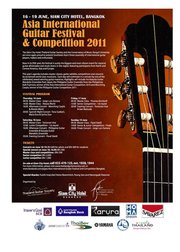This Is No Longer the Official Website for the Thailand Guitar Society
For a number of years this was the official website for the Thailand Guitar Society.
Content is from the site's 2015 archived pages providing a glimpse of what this site offered its interested visitors.
The official current website for the Thailand Guitar Society is found at thailandguitarsociety.weebly.com/ where you can find the most up to date information
or
go visit their Facebook page at www.facebook.com/thailandguitarsociety/
######
AN UPDATE: 2021
I was excited to see that there is going to be an Asia International Guitar Competition presented by the Thailand Guitar Society in association with Asian Guitar Friends group, among others. Because of the Covid pandemic is with be an online competition. There is even going to be a junior competition. My brother is applying. The Junior program is free choice and must be comprised of pieces from the classical guitar solo repertoire or transcriptions and may include unpublished pieces. If you are not familiar with what constitutes a classical guitar, it has six strings or more. I bought my youngest brother a classical guitar when I was studying for my Doctor of Musical Arts at the Juilliard School of Music in NYC a number of years ago. My room mate, while I was there, was not only a superb musician, but also a crazy slot player. At the time and I believe it still holds, New York State did/does not allow NYS residents to gamble online. But my room mate's home was in Connecticut where it was legal. He introduced me to several online casinos that advertised that they had a large variety of popular slots for US players. I think I had a more enjoyable time watching him play slots than actually playing myself. I was even inspired by his slot playing to compose a jazzy piece of music for one of my classes! I titled it "Slots"!
My brother has sent in his application for the Asia International Guitar Competition along with his video presentation. I'm really proud of him. Prizes will be awarded to the candidates who have a distinctive artistic personality, show charisma and great stage presence and who are able to bring out the poetic value, virtuosity and technical prowess of a varied repertoire. I think he could do well. I am always impressed with his playing.
######

A message to all interested people in Thailand and around the world.
We go a new way with new ideas and ambitions about the classical guitar in Thailand and hope to make it more attractive for all people that enjoy the way of classical guitar playing.
We offer:
- private lessons.
- Ensembles.
- Lessons in group or private for technique.
- Lessons in group or private for interpretation.
- Lessons in group or private for perform on stage.
We try to make the classical guitar more attractive for our members and students. We choose the best staff we know to work with us. Our experience and knowledge from many festivals that we played last years in all parts of the world, our more than 20 years teaching experience at Universities and masterclasses in the festivals that we visited and finally to organize the Thailand International Guitar Festival since 2001, give our students more confidence and more ideas about the way to play classical guitar.
We present everybody the best guitarists and guitar makers in the world. Make contact with other guitar societies and festivals.
Exchange ideas between other countries and between our self.
The Thailand International Guitar Festival advance to the biggest event around the classical guitar in Asia and it changed the name in 2008 to “Asia International Guitar Festival” and we are proud of.
We collaborate together with famous guitarists, for example: Roberto Limon, Ermanno Bottiglieri, Costas Cotsiolis, David Russell, Alvaro Pierri, Pavel Steidl, Hugo Geller, Jorgos Panetsos, Pepe Romero, Flavio Cucchi. Galina Vale, Duo Amadeus , Gentaro Takada, Minoru Inagaki, Dagmar and Josef Zsapka, Jorge Luis Zamora, Roman Viazovskiy, Tomonori Arai and many others.
With famous guitar makers like: Yuichi Imai, Karl Heinz & Falko Roemmich, Kim Hee Hong, Masaki Sakurai, Young Seo, Wiroon Songbundit, Raks Chingsakol, Narongsak Visesnut and we try to get new relation with others.
Visit us at :
1930/1 Sukumvit rd. Between soi 58 and 60, Bangjak, Prakanong, Bangkok 10260 tel 027414943, 0814449804 fax 027414940
or contact us by phone or E-mail.
Woratep Rattana-umpawan
Tel : +66 81 854 9368
Email: worateptgs@gmail.com
Leon Koudelak
Tel: :+66 81 453 1941
Email: leon.koudelak@gmail.com
We welcome everybody. From beginners to high level players at any ages
We hope to get your attention with this information.
Leon Koudelak and Woratep Rattana-umpawan
TGS Courses & Fees
Private lessons fee:
One (1) lesson – 900 Baht
Four (4) lessons/1 month – 3400 Baht (to pay in advance)
Twelve (12) | lessons/ 3 months – 9600 | Baht (to pay in advance)
A Modern Approach to Classical Guitar
Notice that some teachers have a different teaching fee or teaching program,
As well our branches in Pattaya and Korat offer a different teaching fee!
Branches
 Korat Beanch
Korat Beanch
 Pattaya Branch
Pattaya Branch
Sunday, 20 January 2013 20:05 | Written by Admin TGS
4 lessons a 50 minutes/month 2000 Baht! (Pattaya residents only!)
Leon Koudelak, Mobile : 081 453 1941,
Email: leon.koudelak@gmail.com
At a quiet place we offer classical guitar lessons in comfortable teaching rooms and atmosphere.
To make na appointment contact:
Leon Koudelak
Mobile : 081 453 1941,
Email: leon.koudelak@gmail.com
Teaching language: English, German, Spanish, French and Thai.
PERSONNEL
DIRECTORS
 Leon Koudelak
Leon Koudelak
Director
Sunday, 20 January 2013 17:40 | Written by Admin TGS
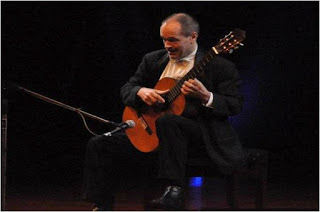
Leon Koudelak is a prize winner of the guitar competition “Fundation Jacinto e Inocencio Guerrero” in Madrid and also received for his artistic performances the Appreciation Price from the Austrian Federal Ministry for science and research. He study with the most famous guitarist and teacher such Karl Scheit at the Vienna Music University, at the Zurich University of the Arts with Konrad Ragossnig and with Julian Bream in Liechtenstein. He obtained the Bachelor Degree, Master Degree (Mag.Art.) and the Master of Arts Education Degree.
As artist he performed in Europe, South America and Asia in countries such as Germany, Great Britain, Spain, Portugal, Czech republic and Slovak Republic, Austria, Switzerland, Italy, Belgium, the Netherlands, Hungary, France, Greece, Liechtenstein, Cuba, Mexico, Japan, Nepal, Malaysia, Philippines, South Korea, Indonesia and Thailand. He did the premieres of works by composers such as Roman Haubenstock-Ramati, Karlheinz Stockhausen and Michael Buchrainer. In 2002 he led the premiere of the guitar concert “Evasion 2002 – “Eschner - guitar concert” by Michael Buchrainer with the “Symphony orchestra Liechtenstein” at the Festival of Liechtenstein LiGiTa.
With Tyrolis Classic he released so far five CDs: 1989 “Guitar Music from Spain, Mexico and Brazil”, 1992 “Modern Trend of Factories for Guitar”, 1994 “Joaquin Rodrigo – guitar music”, 1997 “Pavana Triste” as well as 2002 the last CD, “Exotic Fruits” which became the CD of the year by the “French Technical Periodical”.
2011 the DVD called “ Leon Koudelak live in Seoul” was released by Tyrolis Music.
Leon Koudelak is co-founder of the Liechtenstein Guitar days "LiGiTa", there he serves as artistic director. Today one of the most important music events in Europe. 2001 he found together with Woratep Rattana-umpawan the Asia International Guitar Festival "AIGF" in Bangkok, the largest and most important festivals of the guitar in Asia. Since 2005 Leon Koudelak lives in Bangkok and teaches at the Mahidol and Silpakorn University so as at the Thailand Guitar Society where he holds the position as artistic director.
Teaching language: English/German/French/Spanish/Thai
– Woratep Rattana-umpawan
CONSULTANTS
– Vithaya Vosbein
– Jiradej Setabundhu
+++
STAFF
– Nalin Komentrakarn
E-mail : nalintgs@gmail.com
Mobile Phone : +668-9177-6550
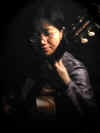
Nalin Komentrakarn
Nalin obtained her Master Degree from College of Music, Mahidol University in 2003 and Bachelor Degree from Kasetsart University. Her teacher are Tawee Maneecharutas and Vidhaya Vosbein. She took masterclasses with Eduardo Fernandez, Timothy Kain, Hucky Eichelmann and Irma Costanzo. She also received Performer's Certificate (Guitar) and Licentiate Diploma (Guitar Performance) from Trinity College (London). Nalin was the second prize winner of Yamaha Guitar Festival 1994. She has appeared as a soloist with orchestra and also gave a regular solo and chamber music recital. Her works are CDs ‘Guitar Lai Thai I,II’ (Thai Traditional Music Arranged for Guitar). In 2007 she was awarded for excellence in music teaching by Trinity Guildhall.
At present she is the head of guitar department of the College of Music, Mahidol University. Besides of her guitar teaching, she teaches music theory as well. She is also a staff of Thailand Guitar Society that organized Asia International Guitar Festival.
– Sakol Siripipattanakul

passionate with classical guitar since age 13, set his goal very eary to become a professional guitarist. In 1992, he graduated from Faculty of Fine and Applied Arts, Chulalongkorn University with second-class honors and has continuously participated in master classes with many world-class international guitarists, such as Alvaro Pierri, Eduarado Fernandez, Costas Cotsiolis, Paavel Steidl, to name only a few.
He has performed humerous recitals and concert continuously and has joined several international renowned guitar festivals in Europe such as in Vienna and Liechtenstein. Moreover, he also participated in several guitar competitions in Thailand and many other countries. In 1998, he won the first prize of Thailand Classical Guitar Competition and many other prizes in the following years. In 2006, he performed in a quitar competition in Vienna where he received a warm welcome from both the audience and other international guitarists.
Currently, he is an active classical guitarist in Thailand and is sharing his individual techniques and his guitar expertise by being a lecturer at Satit Demonstration University, Jintakarn Music Academy and his own private studio. Sakolxxx@yahoo.com
– Pongpat Pongpradit
– Santi Kaewjai
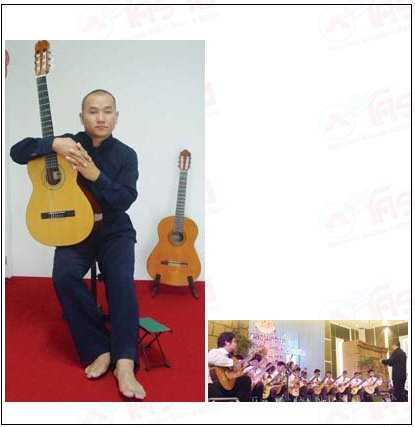
Started to be interested in the guitar after listening to “Romance de Amore” when he was young. After that, he started studying classical guitar with Mr. Sutin Songmahachai in 1984. He continued his studies with Mr.Patti Prateep. After that, he met Mr. Vidhaya Vosbien, who helped him with his guitar teaching career at the Yamaha School in many provinces throughout Thailand. He has since opened his own school, Kanjana Music School, (in Korat) to focus on classical guitar seriously. Nowadays, his school is very well-known in Nakornratchasima
– Apichai Chantanakajornfung
– Ekachai Jearakul
Born in 1987, in Ubonratchathani province, Ekachai Jearakul started playing the classical guitar when he was thirteen years old. In 2003 he was awarded a scholarship to study at the College of Music at Mahidol University where he majored in classical guitar.
He studied with Mr. Worakarn Sangsomboon, Dr. Paul Cesarczyk and many other fine teachers at the University. He later completed and graduated his Bachelor Degree in Classical Guitar Performance with first class honors in 2010. During this time he also attended numerous master classes where he met internationally renowned guitarists including Carlo Domeniconi, Alvaro Pieri, Scott Tennant, Shinji Fukuda, Pavel Steidl, Kantona Twin and many others.
In the fall of 2010 he received a scholarship to complete a Master Degree in Classical Guitar Performance at the University Mozarteum in Salzburg, Austria with Professor Marco Tamayo.
Ekachai has performed solo concerts in Thailand and many other countries around the world including, China, France, Korea, Russia, Greece, Japan, England, Italy, Germany and USA. He has also performed as a soloist with the Dr. Sax Chamber Orchestra, The International Orchestra of Italy, The Seoul Philharmonic Orchestra, The Unity Philharmonic Orchestra, The Thailand Philharmonic Orchestra and The Ukraine Philharmonic Orchestra.
– Tana Suebsiri
– Duan Srisa ard
– Sira Tindukasiri
About practicing/teaching guitar

Konrad Ragossnig “Handbuch der Gitarre”
Handbuch der Gitarre
Konrad Ragossnig
Chapter VI
The Guitar for the lesson
-
Common remarks to the lesson practice
Considering music education as a component part of a broader artistical upbringing, for the one who teaches music, beside the musical-technical aspect, there will also be pedagogical, social and cultural teaching tasks, which are supposed to serve the efficacies, the methodical aid and the goal definition of this summery as a discussion basis within the Methodic lesson.
Although it is quite a common opinion, to say, that music merely presents a pleasant free time activity, which at most is able to serve as a cultural figurehead. Howbeit the fact that the music lesson, as an educational factor, is, by all means, not being equated as highly as other lesson disciplines, and that the ignorance of musical things are not being considered as discriminating, still, music pedagogics and music educators have got to fulfill a piece of art on the solid base of reality, by relating and combining hints to professional perception with humanistic education as much as it is possible, and all this, against various kinds of obstacle (Lack of interest, ignorance, uncertainty).
If the whole human is supposed to be apprehended through musical education, awakening one’s potential to realize music as such, in order to be able to understand and practice it further on, the music educator needs to put his attention to the whole personality of the student. At the beginning of the musical education, especially in the case of teenagers, the teacher will have to inform himself about the age, pre-education and the social background of the student; further on, the teacher should have a clear picture of the students productivity, inclinations of taste, the influence and motivation through parents and friends.
If a teenager is urging for a musical occupation, besides his musical skills, which can be assessed through a talent examination (to sing intervals, to clap rhythms, to see the difference between Major and Minor, paper singing, short melodic and rhythmic improvisation), the teacher needs to also pay attention to the spiritual and physical fitness of the student. The occupation of the musician, should not at all, be a substitution for the discontentment or failure in any other field of activity.
As a principle for the lesson methods, the teaching form with questions helps to promote the student to cooperate actively in the lesson, right from the beginning. According to the age, talent and advances of the student, the teacher will ponder between instructing and self-realization, showing and copying, leading and letting grow, and in the course of this, connecting the musical education with common pedagogical aims, such as the promoting of concentration, mindfulness, interest, ambition, advances and purposefulness. >>The secret to a good lesson, especially when working with kids, is to always intrigue and stimulate the student again and again, without loosing sight of the methodical structure.<<119
The instructions of the teacher should be presented to the student as clearly as possible. The student has to know exactly, where he has to put his attention: on the proper way to hold the instrument, on the rhythmical sequences, on the cleanliness of the tones, on the perception of melody and accompanies, on technical flawless interpretation and so on; whereas technical difficulties in the coordination and dependence between right and left hand, are supposed to be practiced separately.
The structure for an optimal lesson resulted from the consideration of different teaching objectives.
In the center lies the experience of sound, the conscious realization of music, the organic development of musical and technical skills, which, in a systematical structure, needs to be promoted right at the beginning.
-
melodic and rhythmic aural training (guide to conscious hearing);
-
singing realization of a melody and
-
put them into notes and play back on the instrument;
-
Creations on theoretical foundations (intervals, kinds of tones, cadences, agogic, dynamic);
-
systematical expansion of techniques;
-
Anticipation of musical and technical problems (Upbeats, triplets, punctuations and so on.) through musical invention practices under implication of folk melodies (singing or the instrument), which can be substituted with etudes later on.
-
Transpositions of simple melodies (five tone sequences) in different positions and on different chords ease the acknowledgment on the fingerboard.
When the basic posture & positioning techniques of the instrument and the creation of the tones are explained, as well as a manual playing skill has been reached, it is recommended to design the order of the lesson as following:
-
Technical and tone making exercises (scales).
-
Etudes
-
A piece of performance, whereas necessarily corrections will not be done during the foreplay, but will be reviewed not before the end of the performance (picking out the difficult parts).
-
New conceptual formulation with explanations of the technical and musical features (if given, through the foreplay by the teacher).
-
Short paper-play exercises, which could also be related to the new given piece of work.
-
Remedial duet plays between teacher and student; on the lower grade, it is also possible to give hearing improving tasks or cadence kind of connections and their transpositions, which can be used to practice.
For the starting lesson, especially in music schools, it is often recommended or asked to do an instrumental group lesson. Hereby, not more than four students should be put into one group, otherwise, it would possible for the teacher to have a conscious control over the situation. Performing for and mimicking the teacher in group pisions (each group is made of two students) or the cooperative playing by the teacher and a single student will lift up the synchronized production of music as well as the critical listening. Through hearing improving and rhythmical exercises within the group, the lesson can become more relaxed and enriched. However, the single lesson remains the core of musical education, and should be kept as an optimal teaching form, in addition to a permanent group lesson setting.
For the practical studies in the play-literature in the middle and advanced level, the following procedure is recommended:
-
Analysis about the character and style of the piece of work, which has been given to study (dance, sonatas, variations, fantasies and so on).
-
The definitions of the finger sets are supposed to be according to the tempo and phrasing of the piece of work.
-
Memorial processing, remedially in defined segments (optical, acoustical and technical-manual); possible finger set corrections.
-
Practicing of the difficult parts through slow playing.
-
Contemplative pauses will often turn out to be quite useful.
-
The post processing (interpretation) of the piece of work in the whole.
Until about into the third decade of his life, the young musician will remain more or less under the influence of his teacher or any other respected role model. In the present musical education, the utility of the CD and the tape in reasonable using should not at all be ignored. Masterly CD-records could – in supplement with the immediate concert experience – help the young musician, to learn the melodious and technical possibilities from various points of view. One’s own interpretation is not supposed to be fixed as the reflection of the listened music.
-
Guide to daily practice
No serious teaching and lesson method can renounce(?), helping the student to get used to the long continuity of a funded technical as well as musical education right from the first lesson, in which the mastering, can be gained only through lifelong operating, and be obtained only through constant practicing. In fact, benefit for the musical figuration is only reachable, when the daily practicing times are taking secure positions within the daily routine. The practicing requires a special technique, which, along the guiding of the teacher, can be learned over again and again. The following rules are summarized here, to help acquiring performance raising practicing techniques:
-
The daily practicing program should be structured in technical practices (Tone scale, Arpeggios, coordination exercises and the independency from Holding and Stop technique, Barre, Legato, percussion), etudes and performing pieces.
-
Tone scale exercises in slow tempo as well as practicing with Vibrato, whereby the players own tone quality is best expressed.
-
Practices should be done in good aired rooms, rather than in warm ones.
-
A constant outlast of time should be kept, which however, will only adduce the greatest possible rising of the output, as long as one is physically and mentally fresh. Having breaks for relaxation as soon as there are signs of fatigue. The daily outlast depends on the talent, age and physical constitution. It should be handled inpidually flexible.
-
Technical exercises and etudes should, if possible, be practiced by heart.
-
Always practice slowly, until sureness in all technical and musical detail is reached.
-
Depending on the talent and advance, there are three important factors for memorizing a piece of work, which begins right from the concentrated reading through the visual recording of the display of notes, the acoustic recording by hearing and the muscular in accordance with the finger movements of both hands. The rule of thumb would be formulated in about this way: One should begin memorizing, when it is possible to produce certain sentences in slow tempo, without aggravating mistakes, especially without interruptions.
During the memorizing exercises, the note text should be followed in optical imagination. Go back to the text as soon as there gaps of memory! Correct sources of mistake right away!
-
The height of the sitting- and foot bench should be in a natural relation to the body height: The sitting area should rather be low than too high, the foot bench should rather be high than too low, so that the upper part of the body will not have to be too cambered.
-
Set the feet in the way that allows a flexible holding of the instrument, which means: only about half of the left foot supported on the edge of the foot bench, right foot set slightly backwards, close to the right chair leg, so the heel won’t touch the ground. Both shoulders should not be pulled up, but should fall down relaxed.
-
If any of the numerous variation of guitar holding posture is used, the same guidelines are counting for a relaxed posture and the using of the foot stool.
-
Playing in front of the audience can, as a preliminary practice, be tested by the family or among a circle of friends. A rule to thumb, which Hans-Martin Linde recommended to the block flute players for effective encountering with nervousness, can be verbally adopted by guitar players – the conception: >> Chin up – letting the shoulders fall down.<< >> take deep breaths during breaks and the whole body, especially the fingers needs to be consciously relaxed. It is also possible to relax the cervix and the shoulders during playing. <<121
-
Finger setting markings or, if possible, their corrections relieve very much the process of reasonable practicing and have great influence in defining the phrasing. However, finger settings are only useful, if it’s possible to realize them optically coherent to the note text.
In the course of this, a unified punctuation needs to be regarded:
1, 2, 3, 4 as the finger setting indication for the left hand need to be in front of the specific note, not behind, above or under;
p, i, m, a, as the finger setting symbol for the right hand need to be above or under the specific note:
Technical linking arcs (left handed Legato) are distinguished reasonably through a punctured arc ……… for the first time in the edition of Julian Bream
If the common linking arc ______ is used, a finger setting inscription for the right hand (p, i, m, a) should attached, especially where a left handed Legato is put over one or more than two notes, in order to be able to distinguish the technical Legato arcs from phrasing arcs:
Technical Legato
Technical Legato with phrasing arc
Practicing is a practical meditation. Effective practicing will always remain important, pushing back spontaneity for the time being. >Taking in storm < manifests most oftenly as pyrrhic victories; the Ostinato of the teacher: festina lente (hurry slowly) will be the pedantry of the studying ones, as long as the principle of meditation has not been understood. During finger practices, the most uncomfortable positions have got to be practiced tirelessly, however, for a piece of work, all the avoidable difficulties should be avoided.<<122
Only an overall education in technical as well as musical respect can lead to responsible-minded musicians and artists.
NEWS From 2015 & 2016
AIGF 2016
Eduardo Fernandez – live in Bangkok 2016
Thailand Guitar Society proudly presents
EDUARDO FERNANDEZ
Thursday, June 9, 2016, 20.00
@
The Sukosol Hotel, Bangkok
477 Si Ayuthaya Road, Bangkok, Thailand 10400
As part of the Asia International Guitar Festival and Competition 2016, Bangkok
Entry 1000 .- Thai Baht

Festivals
Silpakorn International Guitar Festival 2016
March 1, 2016

Silpakorn International Guitar Festival & Summer Camp 2016
Tuesday 22 March @ Bangkok Art and Culture Centre (BACC)
Auditorium 5th floor.
A r t i s t s
The Philippines :: Gino Misa
Loas :: Vangthanousone Bouaphanh
Indonesia :: Rahmat Raharjo
Singapore :: Zulkifly M Noer
Vietnam :: Danang Guitar Quartet
Malaysia :: Gemilang Trio
Thailand :: Rattasart Weangsamut ,Wong Kojorn Guitar Quartet and Silpakorn Guitar Orchestra
P r o g r a m
1:00-2:00 PM :: Guitar Research Presentation
2:00-3:30 PM :: Guitar Maker Workshop & Exhibition Concert
5:30-6:00 PM :: Young Talent Guitarist Concert
6:00-7:00 PM :: Asian Guitar Friends Concert
7:15-8:00 PM :: Silpakorn Guitar Orchestra Concert
:: F R E E A D M I S S I O N ::
Contact us :: 081-815-9552 (Four)
Facebook :: Suclassical
E-mail :: Sucgcamp@gmail.com
Festivals
TGS Guitar Competition 2016 – Saturday 5 March at Thailand Guitar Society
February 4, 2016

Festivals
ASIA INTERNATIONAL GUITAR FESTIVAL & COMPETITION 2016
January 18, 2016
ASIA INTERNATIONAL GUITAR FESTIVAL & COMPETITION 2016
9 to 12 June 2016 at the Sukosol – Bangkok
All applications

TGS NEW YEAR CELEBRATION 2016
January 5, 2016
TGS NEW YEAR CELEBRATION 2016
Saturday 9 January 2016
@
Kanjana Music school Korat
http://koratclassic.com/
Interview with Woratep Rattana-umpawa
December 29, 2015
Interview with the president of the Thailand Guitar Society, Woratep Rattana-umpawan in Pattaya Mail
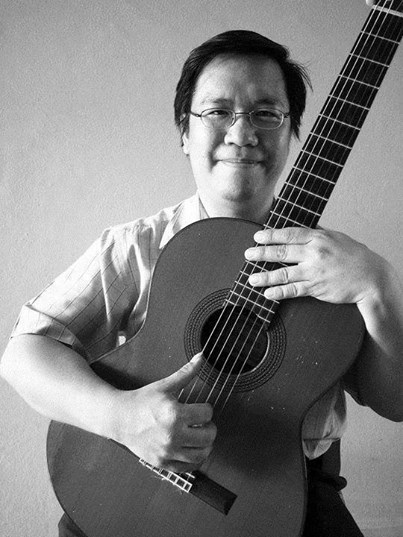
Woratep Rattana-umpawan began his guitar lessons when he was 12. he had been the First Prize Winner of Yamaha Guitar Festival Competition in Bangkok for three consecutive years from 1985-1987. He started taking classical guitar lessons seriously In 1987 he entered the Faculty of Fine and Applied Arts, Chulalongkorn University and got a B.A. with second class honors in Western Music majoring in Classical Guitar. With his talents and skills in performance, he was invited to play solo "Chao Phraya Concerto composed by Prof. Bruce Gaston in 1993. Woratep was once again invited by one of the most famous musical institutions in Japan to perform in three recitals in April 2000. And in November the same year, he had an opportunity to take a private lesson with Mr. Eduardo Fernandez, the world famous guitarist, when Mr. Fernandez was performing a concert in Bangkok. Mr. Woratep used to be Head of the Guitar Department at Chinatkarn Music School in 1991. Moverover, he took part in founding the Bangkok Guitar Quartet and the Bangkok Guitar Society where he took the position of president.
Woratep performs at many international guitar festivals in many parts of the world and often in duo with Leon Koudelak.
He teaches now at the Mahidol and Silpakorn Universities and also at the Thailand Guitar Society.
His works such as Guitar Lai Thai I, II are available on cassettes and CDs.

